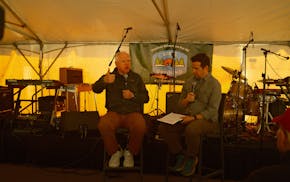As ridership on Amtrak's Borealis line running between St. Paul's Union Depot and Chicago continues to grow, supporters of passenger rail are dreaming that one day the line might be extended farther north to serve cities such as St. Cloud, Detroit Lakes and the Fargo-Moorhead area.
"There is a lot of support for daytime passenger service" along the corridor, said Brian Nelson, a spokesman for All Aboard Minnesota, an advocacy group focused on the expansion and development of intercity rail.
A lot would have to happen before there is any extension of the Borealis, but cities such as Anoka are getting on board. Last month, the Anoka City Council passed a resolution requesting the northwest metro suburb be considered as a stop should the longer line come to fruition.
"We want to have a voice, and let it be known early that we are interested," said Doug Borglund, Anoka Community Development director.
The resolution, passed 5-0 on Aug. 19, formally requests a station be established at the platform on 4th Avenue where Metro Transit's Northstar line currently stops. Northstar is a commuter rail line that runs from Big Lake to downtown Minneapolis with stops in Elk River, Ramsey, Anoka, Coon Rapids and Fridley.
"Passenger rail generates economic growth, reduces highway cost and congestion, and offers excellent mobility and efficiency in transportation," part of the resolution reads. "The City of Anoka continues to support the use of rail for the purpose of passenger transportation and further supports additional use and activity at the existing Northstar station, including a new Borealis passenger rail line stop for area residents and businesses."
The Minnesota Department of Transportation is updating its State Rail Plan to guide the development of the state's rail system for the next 20 years. A Legislature-directed study is also underway to analyze and evaluate bus, rail and other public transportation options along the Minneapolis to St. Cloud to Fargo corridor. A previous study submitted to the Legislature in February looked at what would be necessary to extend the Northstar line from Big Lake to St. Cloud.
"Both studies will inform decisionmakers in planning for the future of transportation in the corridor," said Matt Bailey and Greg Mathis with MnDOT's passenger rail program.
Amtrak spokesman Marc Magliari said any decision about the Borealis lies with MnDOT.
The findings of those studies may determine the fate of the Borealis extension.
"That will reveal where [Borealis] ranks in MnDOT's State Rail Plan," Nelson said. "We believe it will be in there. We just don't know where MnDOT will rank it."
But Nelson believes Borealis stands a chance of earning a high ranking based on how the St. Paul-Chicago portion of the line has performed since service began May 21. The most recent figures from the Wisconsin Department of Transportation show 21,267 passengers took a trip on the line, a 15% increase in July compared to June.
"We believe the same thing could happen between Minneapolis and Fargo," Nelson said, noting the Grand Forks to the Twin Cities corridor is one of the heaviest-traveled corridors in the Upper Midwest. "This is very exciting for passenger rail. We hope it changes the discussion in the Legislature about where we should add it."
MnDOT is also working with the Federal Railroad Administration for updating service plans for the Northern Lights Express, a proposed line from Minneapolis to Duluth. The agency is also ready to work with the Wisconsin Department of Transportation to study Borealis frequency and extending the current line to Minneapolis, Bailey and Mathis said.
Protesters chant after arrest of judge accused of helping man evade immigration authorities
Brooks: Young Minnesotans, register to vote like your future depends on it

Walz casts doubt on environmental safety of mining near Boundary Waters

Minnesota Senate passes bill granting benefits to Hmong and Lao veterans

